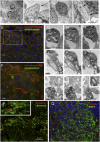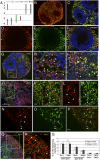Modeling human cortical development in vitro using induced pluripotent stem cells
- PMID: 22761314
- PMCID: PMC3411972
- DOI: 10.1073/pnas.1202944109
Modeling human cortical development in vitro using induced pluripotent stem cells
Abstract
Human induced pluripotent stem cells (hiPSCs) are emerging as a tool for understanding human brain development at cellular, molecular, and genomic levels. Here we show that hiPSCs grown in suspension in the presence of rostral neuralizing factors can generate 3D structures containing polarized radial glia, intermediate progenitors, and a spectrum of layer-specific cortical neurons reminiscent of their organization in vivo. The hiPSC-derived multilayered structures express a gene expression profile typical of the embryonic telencephalon but not that of other CNS regions. Their transcriptome is highly enriched in transcription factors controlling the specification, growth, and patterning of the dorsal telencephalon and displays highest correlation with that of the early human cerebral cortical wall at 8-10 wk after conception. Thus, hiPSC are capable of enacting a transcriptional program specifying human telencephalic (pallial) development. This model will allow the study of human brain development as well as disorders of the human cerebral cortex.
Conflict of interest statement
The authors declare no conflict of interest.
Figures




References
Publication types
MeSH terms
Substances
Grants and funding
LinkOut - more resources
Full Text Sources
Other Literature Sources
Molecular Biology Databases

